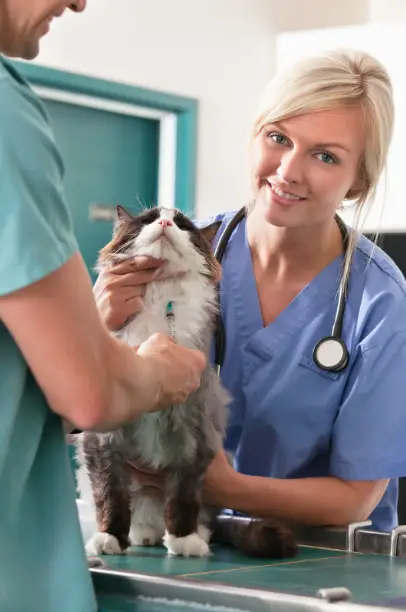Red blood cells (RBCs), also known as erythrocytes, have the primary role of bringing oxygen to tissues. Cells use oxygen to generate energy that the body needs, and during this process, carbon dioxide is left behind as a waste product. The red blood cells expel carbon dioxide from the tissue.

Red blood cells develop in the bone marrow, and all blood cells inside the bone marrow originate from a single cell called a stem cell. This stem cell divides to form an embryonic type of cell that produces platelets, white blood cells, and red blood cells.
Mature red blood cells have a short lifespan and must be constantly replaced by the body. In healthy animals, this occurs naturally, but if there is some type of condition at work which hinders the production of these cells then your cat’s health can quickly degrade.
For example, the kidneys are very important to the health of your cat’s blood. The kidneys produce Erythropietin, which promotes red blood cell production within the bone marrow. When the kidneys are not functioning properly, the health of every other body system is in danger, and this means that red blood cell production, tissue repair, and other vital processes will quickly cease to function.
This is why regular health checks are essential for the health of your feline friend. Severe issues, such as feline leukemia, or feline immune-deficiency can go unchecked otherwise, endangering your cat’s life.
However, if you’re proactive about prevention, and you get regular check ups from your vet, the risk of these and other life-threatening ailments can be mitigated or eliminated. Low red blood cell count in cats can point to serious health issues, and it’s important to take it seriously if it comes up during your cat’s routine vet visits.
What Can Negatively Impact Your Cat’s Red Blood Cell Count?
In most cases, disease is what impacts your cat’s red blood cell count the most. Disorders or external factors which impact the bone marrow include kidney failure, toxins, or feline leukemia virus. If your cat does have anemia, it is a symptom of a greater underlying illness.
However, in some cases, a decreased red blood cell count can be attributed to poor nutrition. Or, even fleas if the animal loses a large enough amount of blood from an infestation. This is known as regenerative anemia.
How To Increase Red Blood Cells In Cats With Better Nutrition
I want to be clear that there is not a “home” cure for anemia. If you believe that your cat may be anemic, they need to go to the vet right now, as their condition could be very serious and they could die. This section is intended to help prevent cats from becoming anemic only, and is not intended to be the only step that you take.

If you’re afraid that your cat’s red blood cell count may be a bit low, then some diet changes could be in order. We have an article here at Beanietoes that will help you to put your cat on a better diet.
Adding iron rich foods to your cat’s diet is one of the simplest and most effective ways to keep a balanced iron count, and it makes great food for anemic cats too.
A healthy diet consisting of quality lean meats, especially organ meats, can help to improve your cat’s red blood cell count naturally.
Focus on healthy proteins like chicken, turkey, beef, or pork. However, tuna, a favorite of cats everywhere is also very high in iron, and it’s easy to get picky eaters to indulge in it.
You might also consider giving an iron supplement to your cat if they are picky about food or light eaters. A liquid iron supplement for cats, like this one, can be added to any food that you can get them to eat. However, if your cat’s iron deficiency is quite serious, they might require injections from the vet’s office.
The Relationship Between Red Blood Cells and Anemia
Anemia is a medical term that refers to a decreased number of red blood cells in circulation (RBC), hemoglobin (Hb), or both. Anemia itself is not really an illness, but rather a symptom of a greater underlying medical condition which impacts red blood cell production.
Cats can develop anemia in a number of ways, but in short, it occurs when there is a severe reduction of red blood cells. In the case of regenerative anemia, the body will likely be able to repair itself except in the case of extreme blood loss, such as from an injury.
However, non-regenerative Anemia occurs in animals who have other underlying medical conditions which prevent their bodies from naturally producing the red blood cells that they need to survive. These animals will need to have the underlying cause treated first before they can recover.
Signs Of Anemia In Cats

A loss of the natural pink gum color is the most common and typical symptom of anemia and anemic cats will typically have very pale colored gums. (As seen in the bottom right picture.)
You should examine your pet’s gums frequently, because it can give you a hint that there’s something wrong before other symptoms set in.
Anemic cats typically have no strength or stamina, and they may seem to tire very quickly. Check the litter box for “tarry” stools, and look for strange increases in your cat’s heart and breathing rate.
How Is Anemia Diagnosed?
Blood samples are checked for the diagnosis of anemia. These tests are also carried out as an integral part of the CBC count. Packed cell volume, also named as the hematocrit, is the most common anemia diagnostic measure. For an average cat, the red blood cells range between 25-45% of the blood. A cat is anemic when the PCV is less than 25 percent. Additionally, red blood cell count and hemoglobin count are used in anemia studies.
Several procedures for diagnosing anemia are performed on blood samples. Such studies are also shown in the form of a full blood cell count (CBC). Packed cell volume (PCV), also called a hematocrit, is the most prevalent diagnostic measure for anemia. The average cat should have red blood cells that constitute 25-45 percent of the blood. The cat is anemic when the PCV is smaller than 25 percent. Furthermore, red blood cell count and hemoglobin levels are checked for anemia diagnosis.

What Other Tests Are Essential When A Cat Is Anemic?
When a low count of RBCs is seen, it is essential to know new red blood cells are being formed in the bone marrow. Many new RBCs are prematurely released, and such untimely red blood cells called reticulocytes may be stained on the bloodstream to promote their detection.
The presence of elevated reticulocyte numbers suggests anemia. Many automated blood analyzers detect the reticulocyte presence, so your doctor can quickly determine whether the cat has anemia or not.
What Causes Anemia In Cats?
Anemia can be caused by excessive blood loss from injuries, immune disorders (in which the body attacks your cells or organs), cancer, genetic defects, renal and other major organ disorders; infectious diseases; and bone marrow diseases. There is no lack of reasons for anemia. This disorder may also be triggered by human or pet drugs, and even fleas.
Risk Factors
All cats are at risk of anemia in some way because so many different ailments and diseases contribute to anemia. For example, if parasites like worms or flukes infest your cat, blood loss, or anemia may occur – another reason why tick and flea prevention is essential! Some medications can also raise the risks of anemia, such as cancer therapy medications and anti-inflammatory drugs.
Feline Anemia Treatment
Whenever a cat is anemic, the root cause must be identified. Depending on the animal’s symptoms and history, the veterinarian will prescribe various tests. These tests may include a total blood count to assess how anemic your cat is, how your cat’s body responds to anemia and develops new RBC’s, a blood film (thick or thin) to check for blood parasites, and characteristics of blood cell chemistry tests to check liver, pancreatic function, kidney, and sugar levels, and electrolyte checks to establish their dehydration status and any electrolyte imbalances.
Typically, a complete urinalysis is also done to remove infections of the urinary tract and to determine the renal concentration of urine, and specialized tests to classify infectious diseases. (i.e., multiple titers or PCR testing)
If your cat’s anemia is so severe that it is life threatening, it will require a blood transfusion. Blood samples will be taken for diagnostic testing or blood typing before your cat gets their transfusion. A blood transfusion is meant to stabilize your cat while identifying the root cause of the anemia and then start taking action using other therapies.
Cat Blood Transfusion Costs
Cat blood transfusion costs can total $500 or more, which includes the determination of their blood type, sedation, and transfusion. For most pet parents, this is a large expense, but there are services which can make it easier to bear this financial burden.

Upon diagnosis of the underlying condition causing the anemia, further treatment will be recommended. Corticosteroids, deworming medications, other medications, or surgeries may be used in these treatments. Your veterinarian will prescribe a detailed care plan based on medical test results for your cat’s conditions.
Feline Anemia Prevention
As they say, an ounce of prevention is worth a pound of cure. So, even if your cat is not yet anemic, it’s important to monitor their health to make sure that they don’t become anemic. Since Anemia has so many route causes, your best course of action in preventing it is routine care.
Make sure that your cat regularly goes for their vet appointments, check their gums for signs of discoloration regularly, get them their vaccinations, and make sure that they are on a proper flea prevention regiment.
If you see any signs covered in our “symptoms of anemia” section, contact your vet immediately for a health check up. If caught early, the prognosis for recovering from feline anemia is very good.


